21 Search Results for infants
September 12, 2019
by Carole Zangari -
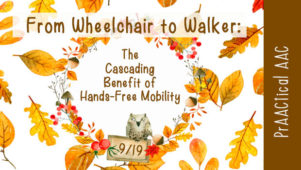
When young children with significant motor challenges are unable to move freely around the environment, it impacts many things. Today, we introduce a limited series on why hands-free mobility is so crucial during the early years, and what we can do to promote independent mobility. We are extremely fortunate to have Christine Wright-Ott authoring this series. Christine is an Occupational Therapist and consultant at The Bridge School in Hillsborough California. She authored the chapter, Mobility, in several editions of the book, Occupational Therapy for Children. Christine lectures at universities and conferences including ATIA, Closing the Gap, ISAAC, ISS, and AAC by the Bay. ::::::::::::::::::::::::::::::::::::::::::::::::::::::::::::::::::::::::::::::::::::::: Why Hands-free Mobility Matters for Children with AAC Needs Speech-language pathologists and occupational therapists have long been aware of the many ways that mobility and communication go hand-in-hand. Without a way to move around, a child’s opportunities for incidental learning and motivation to communicate are severely... [Read More...]
January 13, 2019
by Carole Zangari -
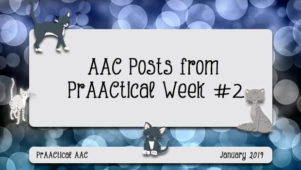
Happy Sunday, AAC friends. Here are some posts from our prAACtical week. Monday – PrAACtical Resources: Explore AAC Tuesday – AAC Link Up Wednesday – Video of the Week: Raising a Child Who Uses Eye Gaze AAC Technology Thursday – Throwback Thursday: Engaging AACtivities for AAC Learning :::::::::::::::::::::::::::::::::::::::::::::::::::::::::::::::::::::::::::::::::::::::::::::::::::::::::::::::::::::::::::::::::::::::::::::::::::::::::: Ready for a few more posts to browse? Here’s a sampling that you might enjoy. Does AAC Really Work with Infants and Toddlers? Research Tuesday: Photos Versus PCS – Babies Weigh In AAC & AT Supports in Early Intervention AAC Mythology v2.0: A Few Misconceptions About AAC Intervention PrAACtical Intervention Ideas: AAC Learning with the Toys, Websites, and Apps You Love
September 6, 2018
by Carole Zangari -
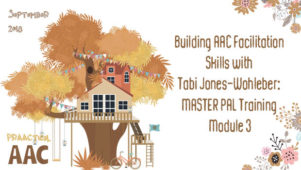
Our training series continues with West Virginia-based SLP Tabi Jones-Wohleber, who works with the AT Team for Frederick County Public Schools in Maryland and provides services to infants and toddlers in the West Virginia Birth to Three programs. In the first two posts, Tabi shared the Overview and Modeling modules and their accompanying resources. In today’s post, the training focuses on an important topic, motivation. ::::::::::::::::::::::::::::::::::::::::::::::::::::::::::::::::::::::::::::::::::::::::::::::::::::::::: Model as a MASTER PAL Module 3: Motivate Facilitator Guidelines Genuine motivation goes well beyond gummies and goldfish; reinforcers are only one small part of the picture as we endeavor to understand what truly drives an individual’s desire to learn and communicate. So much of the time it is the quality of the relationship and the meaningfulness of the interaction. This module discusses the importance of motivation in learning and engaging, whether intrinsic or extrinsic, as well as the undesirable consequences that occur when lack of motivation... [Read More...]
January 10, 2018
by Carole Zangari -
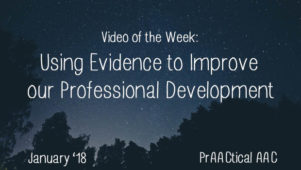
Are you involved in training others on AAC content? Today, we share a video developed by the Virginia Early Intervention Professional Development Center for their Early Intervention-Early Childhood Professional Development Community of Practice. The video discusses an approach to using research evidence to improve the way we design and deliver professional development. You can see the article on which this model is based (Dunst, 2015) by clicking on the reference below the video. Direct Link to Video: https://www.youtube.com/watch?v=eSnREyBWEEc ————————————————- Dunst, C. J. (2015). Improving the design and implementation of in-service professional development in early childhood intervention. Infants & Young Children: 258, 3, 210-219.
June 1, 2016
by Carole Zangari -
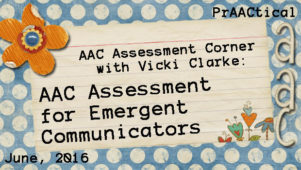
Today, we welcome back Vicki Clarke with more helpful information on conducting AAC assessments. If you work with individual who are at the early stages of communicative development, this post is for you! :::::::::::::::::::::::::::::::::::::::::::::::::::::::::: Some of my most favorite students are those who, at first, may not seem to notice me at all. Sometimes these students seem to exist in their own worlds. They don’t seem to respond in ways we would expect: looking, attending, listening, or gesturing. They may have a diagnosis of Autism, significant developmental delay, epilepsy, or any number of syndromes. I love these kids, and unfortunately, these are often the students who don’t get referred to me. Sometimes it takes years of working in a district before I get to see students with significant developmental delays. These children are typically served in classrooms for students considered to be severe/profound or multi-handicapped. Honestly, I usually get the... [Read More...]
September 9, 2014
by Carole Zangari -

We’re back again with another Research Tuesday post, a series organized by Rachel Wynn of Gray Matter Therapy, in which bloggers are encouraged to write about a research article that they’ve read recently. (You may also know Rachel from her amazing work in advocating for ethical services in skilled nursing facilities.) For our September post, we look at a study done with babies to see how they like different AAC symbols. SLPs frequently assume that children with AAC needs better understand and prefer photos to other forms of picture symbols used in AAC. In this article, we look at the work of special educator Alexandra DaFonte whose work gives us some insight into this issue. In this study, she sought to determine if typically developing infants at 6, 9, and 12 months of age responded to two types of graphic symbols used in AAC: actual photographs and Picture Communication Symbols... [Read More...]
February 6, 2014
by Robin Parker -
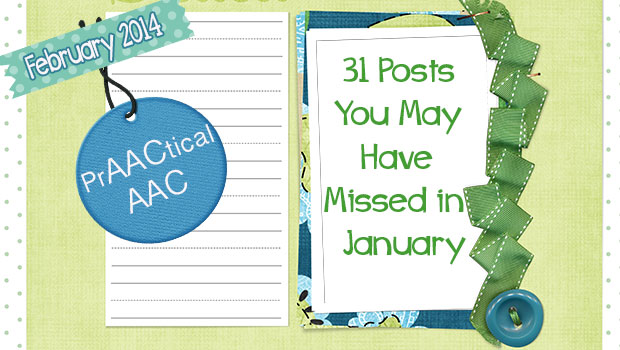
Strategy of the Month: PrAACtice Opportunities Building a PrAACtice Routine PrAACtical Communication Opportunities in SLP Sessions Using Aided Language To Build Communication Opportunities PrAACtical Excercise: Building Fluency with Decontextualized PrAACtice PrAACtical Thinking Ringing in the New Year with an AAC App Giveaway- acorn Another Year of Core Vocabulary Get Organized for the New Year- 5 Visual Schedule Apps A PrAACtical Week: 2014 #1 Watch it Wednesday- Pain in Children with Developmental Disabilities PrAActical Peek: Decorating Cookies 31 Posts You May Have Missed in December A PrAACtical Week 2014 #2 Does AAC Really Work with Infants & Toddlers Watch it Wednesdays- Using and Creating Routines to Promote Interactions Throwback Thursday: Visual Schedule Roundup A PrAACtical Note of Appreciation A PrAACtical Week 2014 #3 Watch It Wednesday: I Hear Them All A Totally Different Life A PrAACtical Week #4 SpeakAll! A Research-to-Practice Project Make It PrAACtical: Make Your Own Battery Interrupter (Without Soldering) ... [Read More...]
January 18, 2014
by Robin Parker -
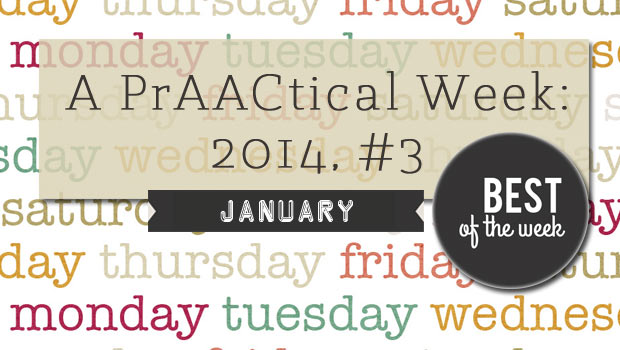
It’s been an awesome PrAACtical Week. Take a look: Sunday: PrAACtical Communication and a Business Monday: PrAACtical Communication Opportunities in SLP Sessions Tuesday: Does AAC Really Work with Infants and Toddlers? Wednesday: Watch It Wednesday – Creating and Using Routines to Promote Interaction Thursday: Throwback Thursday – Visual Schedule Round-Up Friday: A PrAACtical Note of Appreciation (Don’t miss the downloads!)
May 23, 2013
by Carole Zangari -
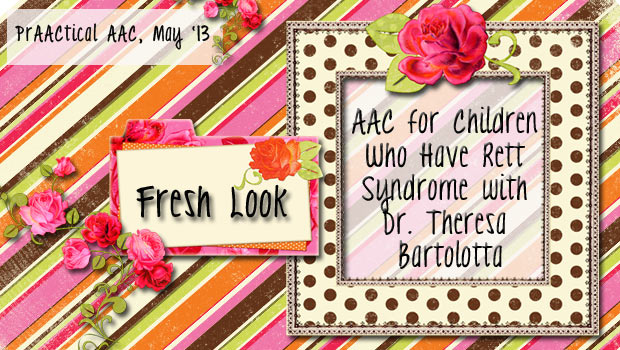
In our SLP training programs, few of us learned about Rett Syndrome or how to provide services to children with that disorder. We’re so pleased to have a guest post on AAC services for children with Rett by Dr. Theresa Bartolotta, Director of Assessment in the Office of the Provost, and Associate Professor in the Department of Speech-Language Pathology, at Seton Hall University, in South Orange, New Jersey. An SLP with over 30 years of clinical experience, she specializes in communication disorders in children with significant disabilities with a special interest in autism and Rett syndrome. Our field is still learning about Rett syndrome and we are still discovering new things about the range of skills and abilities present in the children who have it. In this post, Dr. Bartolotta gives us some background about the syndrome and discusses implications for treatment. I am thrilled to have this opportunity to post... [Read More...]
May 14, 2012
by Carole Zangari -
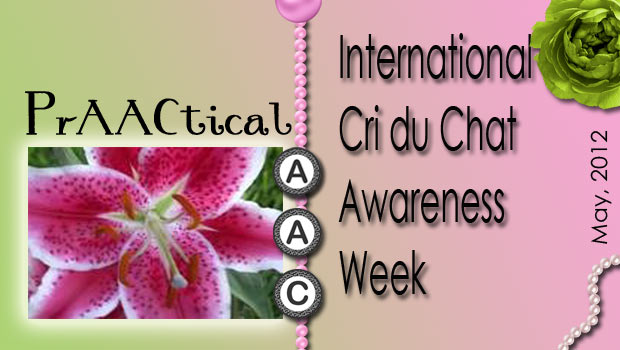
– Today’s post is in honor of the first ever International Cri du Chat Awareness Week and the lovely young lady pictured here (as well as in the brochure linked below). – Cri Du Chat Syndrome (CdCS, also called Lejeune’s syndrome and 5p deletion) is a low incidence genetic disorder caused by a deletion on the short arm of chromosome 5 (5p-). Most children with CCS experience general developmental and communication delays, some of which are quite significant. They tend to have strengths in receptive language. Their speech is often marked by frequent articulation errors, small phonetic inventories, and restricted syllable shapes. Many infants and children with CdCS also have feeding and swallowing difficulties. Children with CdCS have a higher co-occurrence of cleft lip/palate. – 1. 5p- Society (US) and the Annual Conference: Positive Attitude, Reaching New Heights (July, 26-29 in Denver, CO). This group also has a network of... [Read More...]









